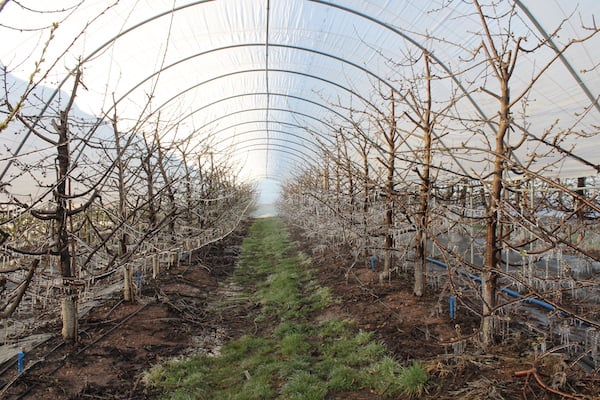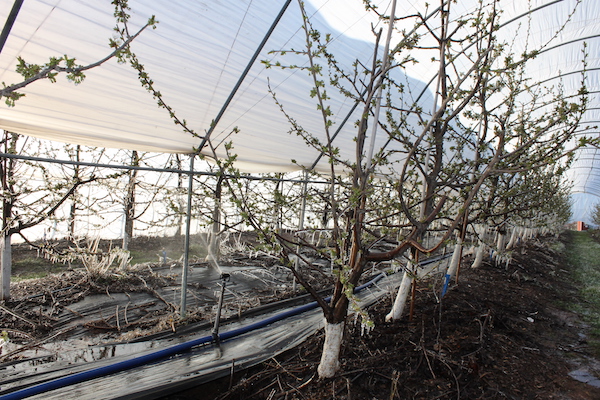The Freeze Event
Temperatures and wind both affect our crops. When it isn’t windy, cold temperatures can settle in lower areas, and sometimes we’ll see a five-degree difference between hilltop and valley temperatures. When it is windy, the temperatures do not vary as much.
On Monday night we had 10-14 m.p.h. winds and temperatures were down to 24.5 to 26 degrees. Because of the wind, the temperature was similar at high and low elevations.
On Tuesday night temperatures went down to mostly 19-23 degrees, but we saw a lot of variation in this because the winds were very light (2 m.p.h.).
Why Our Crops Are So Vulnerable This Year
Due to the milder winter, the stage of growth for most crops is two weeks ahead of schedule, making them more susceptible to damaging temperatures. For example, peaches at pink stage (the stage right before blooming) can withstand temperatures down to 20 degrees before there is significant damage. At bloom stage, if temperatures drop to 24 degrees, there will be significant damage. Most of our peaches were at full bloom; however, we are hopeful about their crop potential.
What We Have Done to Protect Some Crops
Sweet Cherries: We decided to try to protect the one block with highest potential that has a high tunnel structure, covering it with the plastic entirely and setting up sprinklers to irrigate the area. Pumping 55-degree water into the enclosed structure helps to raise the temperature inside the high tunnel. And even though it may seem counterintuitive, the water releases some heat as it freezes, and it protects the plant.
Strawberries: We installed lightweight row covers on the earlier varieties that can give 5-7 added degrees of protection. The later varieties were still covered with straw, which we chose to leave on until we get past the threat of freezing temperatures.
Many of our fruits: We have also spent a large amount of time spraying apples, peaches, cherries, plums, blueberries, etc. with nutritional sprays. Studies have shown that applying certain nutrients helps to reduce stress on the plants, making them slightly more resistant to damage. It can give 1 -2 added degrees of protection.
What we did NOT do: We did not apply heat. In some situations lighting fires can help, but with the winds, especially the first night, we decided it would be tough to contain the heat.
The Outlook Thus Far
Keeping in mind it is difficult to evaluate accurately in the first 48 hours–because sometimes damage is not seen until 1-2 months later–here is our assessment of crop potential.
Strawberries
Stage: Pre-bloom
Outlook: Good crop potential
Raspberries & Blackberries
We had been concerned about the warm temperatures in December when the leaf shoots started to grow. However, their overall plant health coming out of the winter is better than we have seen for a few years. We have not been able to see damage from this event.
Outlook: Optimistic
Blueberries
Stage: Pre-bloom
Outlook: Very slight damage, but good crop potential
Kiwiberries
Stage: Early growth
Outlook: Good crop potential (however, as a newer crop, they are more difficult for us to assess)
Apricots
Stage: Past bloom
Outlook: Severe damage
Plums
Stage: Late Bloom
Outlook: Slight damage, but good crop potential
Sweet Cherries
Stage: Early bloom
Outlook: Able to protect 1.5 acres under high tunnel, good crop potential in that area. Severe damage in other areas not protected by high tunnel. May be a light crop in some varieties.
Sour Cherries
Stage: Pre-bloom
Outlook: Light bud set due to very heavy crop last year. Some damage, and light crop potential.
Peaches
Stage: Mostly full bloom
Outlook: Varying damage depending on elevation and variety. Heavy bud set overall. Good crop potential.
Apples
Outlook: Able to find damage in many varieties, but only slight overall. Very good crop potential.
Pears
Stage: Pre-bloom
Outlook: Damage varies by pear variety. Some varieties still have good crop potential, others light crop potential.
Thank you for your concerns for our crops! We are working to protect the fruit, hoping for steadier weather ahead, and looking forward to making wonderful memories at pick-your-own this summer!


